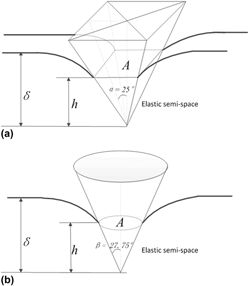Crossref Citations
This article has been cited by the following publications. This list is generated based on data provided by
Crossref.
Zhu, Xinyao
Liu, Lanjiao
Wang, Zuobin
and
Liu, X.
2017.
Axisymmetric Contact Problem for a Flattened Cell: Contributions of Substrate Effect and Cell Thickness to the Determination of Viscoelastic Properties by Using AFM Indentation.
Scanning,
Vol. 2017,
Issue. ,
p.
1.
Tao, Ran
Wang, Chengzhang
Lu, Yin
Zhang, Changwei
Zhou, Hao
Chen, Hongxia
and
Li, WenJun
2020.
<p>Characterization and Cytotoxicity of Polyprenol Lipid and Vitamin E-TPGS Hybrid Nanoparticles for Betulinic Acid and Low-Substituted Hydroxyl Fullerenol in MHCC97H and L02 Cells</p>.
International Journal of Nanomedicine,
Vol. Volume 15,
Issue. ,
p.
2733.
Chen, Mengdan
Zeng, Jinshu
Ruan, Weiwei
Zhang, Zhenghong
Wang, Yuhua
Xie, Shusen
Wang, Zhengchao
and
Yang, Hongqin
2020.
Examination of the relationship between viscoelastic properties and the invasion of ovarian cancer cells by atomic force microscopy.
Beilstein Journal of Nanotechnology,
Vol. 11,
Issue. ,
p.
568.
Liang, Wenfeng
Shi, Haohao
Yang, Xieliu
Wang, Junhai
Yang, Wenguang
Zhang, Hemin
and
Liu, Lianqing
2020.
Recent advances in AFM-based biological characterization and applications at multiple levels.
Soft Matter,
Vol. 16,
Issue. 39,
p.
8962.
Wang, Lei
Tian, Liguo
Wang, Ying
Zhang, Wenxiao
Wang, Zuobin
and
Liu, Xianping
2020.
Determination of viscohyperelastic properties of tubule epithelial cells by an approach combined with AFM nanoindentation and finite element analysis.
Micron,
Vol. 129,
Issue. ,
p.
102779.
Kubiak, Andrzej
Zieliński, Tomasz
Pabijan, Joanna
and
Lekka, Małgorzata
2020.
Nanomechanics in Monitoring the Effectiveness of Drugs Targeting the Cancer Cell Cytoskeleton.
International Journal of Molecular Sciences,
Vol. 21,
Issue. 22,
p.
8786.
Chen, Yu
Li, Ruokun
Yang, Yuchen
Ma, Di
Zhou, Jiahao
Wang, Chengyan
Kong, Linghan
Chen, Yongjun
Yan, Fuhua
and
Feng, Yuan
2022.
Correlation analysis of structural and biomechanical properties of hepatocellular carcinoma tissue.
Journal of Biomechanics,
Vol. 141,
Issue. ,
p.
111227.
Tian, Yanling
Lin, Wangjiang
Qu, Kaige
Wang, Zuobin
and
Zhu, Xinyao
2022.
Insights into cell classification based on combination of multiple cellular mechanical phenotypes by using machine learning algorithm.
Journal of the Mechanical Behavior of Biomedical Materials,
Vol. 128,
Issue. ,
p.
105097.
Zhu, Xinyao
Qin, Rui
Qu, Kaige
Wang, Zuobin
Zhao, Xuexia
and
Xu, Wei
2023.
Atomic force microscopy–based assessment of multimechanical cellular properties for classification of graded bladder cancer cells and cancer early diagnosis using machine learning analysis.
Acta Biomaterialia,
Vol. 158,
Issue. ,
p.
358.
Injac, Rade
2023.
Potential Medical Use of Fullerenols After Two Decades of Oncology Research.
Technology in Cancer Research & Treatment,
Vol. 22,
Issue. ,
Huang, Yuxi
Yang, Fan
Wang, Xia
Liu, Chuanzhi
Song, Guicai
and
Wang, Zuobin
2023.
Deep Learning Based Classification for AFM Images of Cancer Cells.
p.
96.
Ricci, Martina
Barbi, Elisa
Dimitri, Mattia
Duranti, Claudia
Arcangeli, Annarosa
and
Corvi, Andrea
2024.
Sonoporation, a Novel Frontier for Cancer Treatment: A Review of the Literature.
Applied Sciences,
Vol. 14,
Issue. 2,
p.
515.
Sabri, Elias
and
Brosseau, Christian
2024.
Electromechanical interactions between cell membrane and nuclear envelope: Beyond the standard Schwan’s model of biological cells.
Bioelectrochemistry,
Vol. 155,
Issue. ,
p.
108583.
LEI, Meng
LIU, JingYi
XIE, YiZhou
MA, YuFei
XU, Feng
and
WEI, Zhao
2024.
Biomimetic viscoelastic polymeric hydrogels and their biomedical applications.
SCIENTIA SINICA Vitae,
Vol. 54,
Issue. 3,
p.
428.




